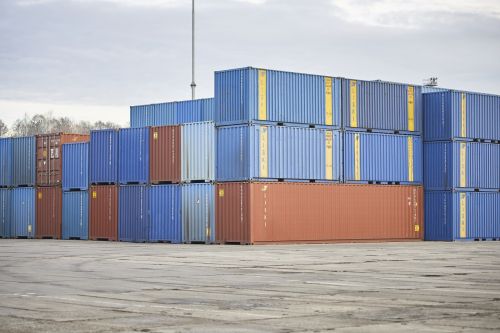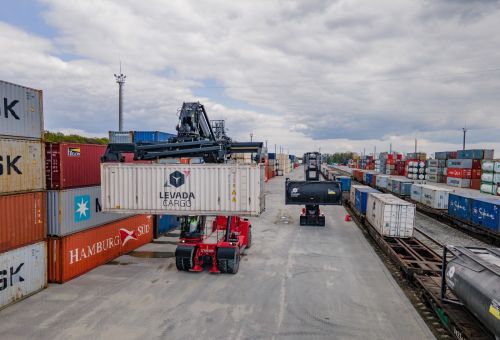Last year, the Ukrainian market of containerized cargo grew both in terms of transport volumes and investment attractiveness. The opening of maritime corridors and integration into the TEN-T are the main incentives for the continuation of this positive dynamic.
The market of containerized cargo in Ukraine gained momentum in 2023 despite the economic slowdown during martial law. The major players in the market are already talking about a return to the pre-war market indicators, and the facilities for handling containerized cargo—especially multimodal complexes and dry ports—are the primary targets for investment in the transport industry. What is behind this growth, apart from the traditionally low percentage of containerized cargo flows in Ukraine, which was a decisive factor influencing the market in previous years?
"Today, the market in Ukraine is being formatted almost from scratch," says a top manager at a line that was one of the three largest in Ukraine before the Russian military invasion. The Russian aggression has not only dramatically changed the vector of cargo flows from the Black Sea to Ukraine’s western border crossings, but it has also shifted the business priorities of the major market players to expanding the capacity of their inland terminals and developing their fleets of containers and railway flatcars.
Ports have a good chance of getting back in the game this year. "The Ministry of Infrastructure, together with the Armed Forces of Ukraine and the Ukrainian Seaports Authority, is working to expand the acceptance of cargo that could be damaged (during Russian attacks on port infrastructure). I am talking about container and ferry transportation," says Yurii Lytvyn, head of the Ukrainian Seaports Authority (USPA). In the direction of the EU, the growth driver is and will be the export-import cargo of agricultural products that is generated in the western regions of Ukraine and already integrated into European logistics chains: the operators that have already developed mechanisms for interacting with European carriers and port operators in member-countries of the European Union will have an advantage. The political framework for this cooperation should be provided by the development of the EU-Ukraine Solidarity Lanes and integration into the Trans-European Transport Networks (TEN-T) corridors.
Both private companies and the state-owned Ukrainian Railways joint-stock company (Ukrzaliznytsia), represented by its subsidiary Liski, have an appetite for growth and the ambition to "rewrite the market for themselves." Whose arguments will be more convincing in the battle for customers' freight?
The top market players
Last year, the four leading players on the market were the state-owned Liski, which operates a fleet of over 3,000 flatcars; the Polish operator Laude; the Ukrainian company Levada Cargo, which is a co-owner of Container Terminal Mostyska (CTM); N'UNIT, a private company that handles intermodal containers (classic containers that can be transported on ships owned by maritime container lines), has the largest private network of terminals in Kyiv, Dnipro, and Kharkiv, and accounts for a significant proportion of the containers handled by CTM.
Liski is the main market maker. According to Ukrzaliznytsia, its container transport volume increased by 34% to 201,200 TEU in 2023, which is roughly the same as its 2019 volume. Of these containers, 62% were exported, 19% were imported, and 19% were transported within Ukraine.
Another market leader, Laude, has said that it lost many customers in eastern Ukraine when the war broke out. However, the company’s volumes began to recover last year. According to Laude, it transported 104,300 TEU of containerized cargo in 2021, 61,200 TEU in 2022, and 89,300 TEU in 2023.
Container Terminal Mostyska, which began operations in the summer of 2022, handled over 72,400 TEU of containerized cargo in 2023. Most of the increase in its cargo volume occurred in the second half of the year and continued to gain momentum after that. "Most of the cargo went to Asia via European ports, as well as to Poland, Italy, and Germany. The increase in the volume of cargo handled was mainly because of the reorientation of shipping lines and the establishment of operations via Polish ports. Another factor behind the increase was the development of production facilities and the provision of new services," said Container Terminal Mostyska.
N'UNIT also announced an improvement in its performance indicators. "The transport volume in 2023 almost doubled compared with 2022, approaching the pre-war volume," the company said.
Promising cargoes
The main growth area for containerized cargo last year was grain and oilseeds, according to all market participants. Ukrzaliznytsia transports mainly grain (49%) and ferrous metals (17%), followed by oil cake (14%) and oil (10%). These are rather atypical commodities for transportation by rail in containers compared to traditional grain hoppers and tankers, and the reorientation is caused by difficulties in exporting cargo by sea and rail.
According to Laude, until 2022, the company’s priority in the field of cargo transportation was the metallurgical sector, as well as the transportation of heavy cargo in its own innovative containers. However, since the outbreak of the Great War, the company has refocused on the transportation of grain and oilseeds. Moreover, the range of products transported by the company is constantly expanding and includes not only metallurgical and agricultural cargoes, but also consumer goods that do not require special temperature regimes. At present, the volume of transportation of such cargoes represents an insignificant part of the total volume, but the company sees the potential for the development of this project.
The main growth areas for N'UNIT in the past year were rail transport and sea transport from the Danube ports to Constanta. The main types of cargo transported are grain and oilseeds. "We have focused on the delivery of all types of cargo in containers to/from Ukraine from/to European ports by rail," the company said.
Container Terminal Mostyska sees deeper integration with the European Union, an increase in the volume of cargo traffic from the European Union, and an increase in the level of containerization as the way forward. There is a special focus on high-margin import cargo. In particular, a new cargo flow—electric vehicles—emerged last year. The terminal received 36 containers and unloaded 108 electric vehicles in 2023.
Appetite for investment
The major market players have traditionally been reluctant to comment on their investment plans. Their priorities, such as the expansion of their wagon fleets and the development of their terminal networks, will remain unchanged. This is dictated by the logic of market development: the most competitive operator is the one that controls all segments – terminals, rolling stock, and the ‘last mile.’ Both state-owned carriers (Ukrzaliznytsia) and private operators understand this.
Accordingly, Liski plans to increase its fleet of containers by 1,000 and its fleet of flatcars by 500 in 2024. In addition, two new facilities in Sknyliv and Chop will become fully operational. N'UNIT is also talking about development. "We plan to develop and invest in the existing network of terminals, and we are seriously considering investing in the fleet of containers and flat cars, but no decision has been made yet. We will react according to the market," the company said.
Oleksii Hrebinets, Laude's logistics director, told CFTS that in 2024 the company will continue to build containers and flatcars and develop private traction in Poland with possible entry into Germany, the Netherlands, and Ukraine on the 1435 mm track gauge. This year, the focus will be on liquid bulk cargo, and the first containers have already been built.
"The plans for 2024 include the development of a project for the transportation of sea line containers, and we do not exclude the possibility of concluding contracts with sea lines to create a depot for the storage and transshipment of sea line containers in the European Union, closer to the border with Ukraine at the terminal in Zamość," said Hrebinets.
Lemtrans, which is the main shareholder of Levada Cargo, also plans to make significant investments in the future. The Lemtrans group invested more than UAH 160 million in infrastructure and logistics projects in Ukraine in 2023, including more than UAH 153 million in the development of its terminal and container businesses. "The business still depends on the potential threat of destruction of the frontline industry and logistics bottlenecks, such as ports and congestion at the border with the European Union. However, despite the war, we are not stopping and are focused on the development of Ukraine. Our investment activities have been a major focus over the past year. We are investing in new infrastructure projects, such as the terminal and container business," said Lemtrans CEO Volodymyr Mezentsev. According to the company, it continued the development of the container terminal in Mostyska and decided to start designing two new container terminals to be built in Ukraine.
The dark horses
Another market trend in 2024 could be the emergence of new ambitious players, which will intensify M&A activity in the industry. In particular, one of the largest financial and industrial groups in Ukraine, which has not previously been involved in transportation, is currently studying the prospects of acquiring a terminal and significantly expanding its capacity. Another major port operator, which had an approved strategy for the development of inland logistics but was forced to suspend its implementation because of the war, is planning to "unfreeze" the project and could launch it as early as 2024.
The concession of the container terminal in the port of Chornomorsk, once the largest in Ukraine in terms of transshipment of this type of cargo, also holds significant prospects for the development of the market. Major global port operators and domestic investors are already showing interest. Their motivation is understandable, as the market is actively reformatting and the new "entry point", backed by relevant experience and financial resources, offers the opportunity to take a dominant position in a promising business.
The decisive factor in shaping the market's prospects in the coming years will be the activities of international container lines, which are now seriously considering the possibility of returning to Ukraine in 2024-2025. "We are waiting for the revival of container transportation from Greater Odesa, which is facilitated by the generally stable traffic of the existing conventional fleet," N'UNIT said.
The arrival of international lines will affect the positions of market players with their own or partner port facilities, and it can also significantly adjust the container cargo flows that currently enter Ukraine through European Union ports and Ukraine's western border.
Another interesting "dark horse" is the renewed interest in the Trans-Caspian Transport Corridor project to bypass Russia, for which the European Union has committed EUR 10 billion. "Russia's invasion of Ukraine has underlined the urgency to find alternative reliable, efficient trade routes between Europe and Asia that do not transit Russia," the European Commission said in a statement. Currently, the main Black Sea logistics route being considered by the European Union bypasses Ukraine and runs through Romania and Turkey. However, we should not forget that the Ukrainian ports of Odesa and Chornomorsk have been included in the maritime segment of the Trans-Caspian Transport Corridor and that the corresponding pilot shipments have been made. Brussels should be reminded that a route through Ukraine could be the shortest and therefore more profitable, with the prospect of integration into the TEN-T corridors. The revival of the commercial and logistical attractiveness of the Trans-Caspian route through Ukraine—which offers significant business prospects and will allow us to talk realistically about the transit capabilities of the country's transport system—is a political task for the authorities.
To sum up, we can say that the growth dynamics of the market will continue in the future. Of course, the safety factor will be the top priority. However, we can already say that integration into the European transport system has significant potential, as does the growth of containerization of the cargo base. All this makes the container segment of the transportation business an attractive target for investments, which are already underway and will continue to increase.




